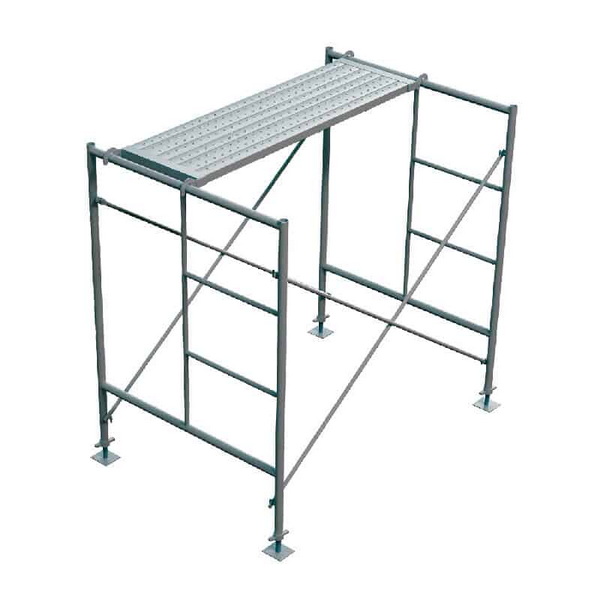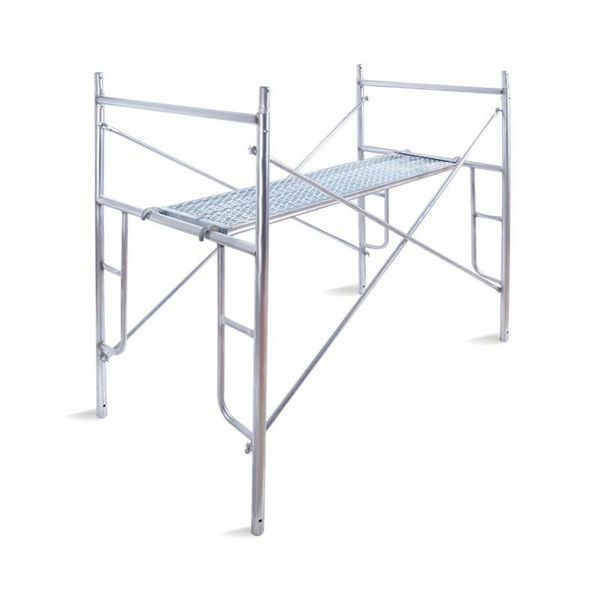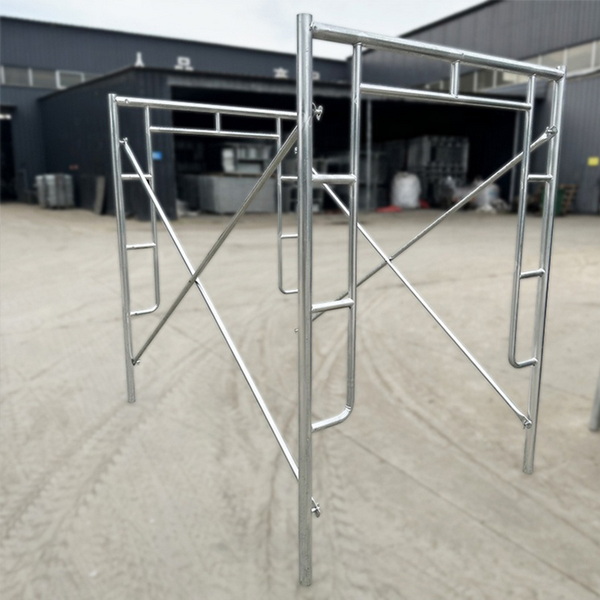Content Menu
● Understanding Frame System Scaffolds
● Benefits of Using Frame System Scaffolds
● Applications of Frame System Scaffolds in Construction
● Best Practices for Using Frame System Scaffolds
● Essential Safety Tips for Frame System Scaffolds
● Common Mistakes to Avoid When Using Frame System Scaffolds
● Regulatory Standards and Guidelines
● The Future of Frame System Scaffolds
● Conclusion
● FAQ About Frame System Scaffolds
>> 1. How often should frame system scaffolds be inspected?
>> 2. What are the key components of a frame system scaffold?
>> 3. What is the maximum load capacity of a typical frame system scaffold?
>> 4. What type of training is required for workers using frame system scaffolds?
>> 5. What are the regulatory standards for frame system scaffolds?
● Citations:
In the dynamic world of construction, ensuring worker safety while maintaining efficiency is a constant challenge. Frame system scaffolds have emerged as a versatile and reliable solution for providing safe access to elevated areas in various construction projects[4]. These systems offer numerous benefits, making them an indispensable choice for construction professionals[4]. This article explores how frame system scaffolds enhance safety in construction, covering their components, benefits, applications, best practices, and essential safety tips.

Understanding Frame System Scaffolds
Frame system scaffolds are temporary structures erected to support workers and materials during construction, repair, or maintenance activities[4]. They are widely used due to their ease of assembly, stability, and adaptability to different project needs[4]. A typical frame system scaffold consists of several key components that work together to provide a safe working platform.
Key Components of Frame System Scaffolds:
- Frames: These are the vertical supports that form the main structure of the scaffold. They are typically made of steel or aluminum and come in various heights to accommodate different project requirements[1].
- Cross Braces: These connect the frames to provide lateral stability, preventing the scaffold from swaying or collapsing. Cross braces are essential for maintaining the structural integrity of the scaffold[7].
- Base Plates: These are placed under the frames to distribute the load evenly and prevent the scaffold from sinking into the ground. Adjustable base plates can be used to level the scaffold on uneven surfaces[7].
- Planks or Platforms: These are the horizontal surfaces on which workers stand and place materials. Planks are typically made of wood, aluminum, or steel and must be capable of supporting the intended load[7].
- Guardrails: These are installed along the edges of the platform to prevent workers from falling. Guardrails typically consist of a top rail, mid-rail, and toeboard[7].
- Toeboards: These are low barriers placed at the edge of the platform to prevent tools and materials from falling off, protecting workers below[4].
- Ladders or Stairways: These provide safe access to the working platform. Ladders should be securely attached to the scaffold and meet safety standards[3].
Benefits of Using Frame System Scaffolds
Frame system scaffolds offer several advantages over other types of scaffolding, making them a preferred choice for many construction projects[4].
- Enhanced Safety: Frame scaffolds are designed to provide a stable and secure working platform, reducing the risk of falls and accidents. Guardrails, toeboards, and secure access points further enhance safety for workers[7].
- Ease of Assembly and Disassembly: Frame scaffolds are relatively easy to erect and dismantle, saving time and labor costs. The modular design allows for quick assembly and adjustments[5].
- Versatility and Adaptability: Frame scaffolds can be adapted to various project needs and configurations. They can be used for both interior and exterior applications and can be adjusted to different heights and shapes[4].
- Cost-Effectiveness: Frame scaffolds are a cost-effective solution for providing safe access to elevated areas. They are reusable and require minimal maintenance, reducing long-term costs[5].
- Stability and Load-Bearing Capacity: Frame scaffolds are designed to support heavy loads, providing a stable working platform for workers and materials. The load capacity of the scaffold should always be clearly marked and never exceeded[1].
Applications of Frame System Scaffolds in Construction
Frame system scaffolds are used in a wide range of construction applications, including:
- Residential Construction: Frame scaffolds are commonly used in residential construction for exterior work such as painting, siding, and roofing. They provide a safe and stable platform for workers to access hard-to-reach areas[4].
- Commercial Construction: In commercial construction, frame scaffolds are used for a variety of tasks, including bricklaying, concrete work, and facade installation. Their versatility makes them suitable for large-scale projects[4].
- Industrial Construction: Frame scaffolds are used in industrial settings for maintenance, repair, and construction of plants, factories, and other industrial facilities. They provide a safe working environment for workers in demanding conditions[4].
- Renovation and Repair: Frame scaffolds are ideal for renovation and repair projects, providing access to interior and exterior surfaces for painting, plastering, and other tasks. Their ease of assembly makes them suitable for short-term projects[4].

Best Practices for Using Frame System Scaffolds
To ensure safety and efficiency, it is essential to follow best practices when using frame system scaffolds[4].
- Conduct Thorough Inspections: Before assembly, inspect all scaffolding components for damage, wear, or defects. Regular inspections should also be carried out during the project to identify any issues that may arise[1].
- Follow Manufacturer Guidelines: Always adhere to the manufacturer's instructions for assembly, use, and disassembly. This includes adhering to weight limits and ensuring proper component compatibility[4].
- Provide Adequate Training: Ensure that all personnel involved in erecting, using, and dismantling the scaffolding are adequately trained. This includes understanding safety protocols and emergency procedures[4].
- Implement Fall Protection Measures: Use guardrails, toeboards, or personal fall arrest systems (PFAS) to protect workers from falls. Ensure that these safety measures are in place and used correctly[7].
- Ensure Proper Assembly: Assemble the scaffold according to the manufacturer's instructions, ensuring that all components are securely connected. Use cross braces to provide lateral stability and prevent swaying[1].
- Maintain a Safe Working Environment: Keep the scaffold platform free of debris, tools, and materials that could cause trips or falls. Ensure adequate lighting and ventilation[1].
Essential Safety Tips for Frame System Scaffolds
In addition to best practices, the following safety tips are crucial for preventing accidents and injuries when working with frame system scaffolds[1]:
- Understand Load Capacities: Knowing the load capacity of your scaffold is crucial. Overloading can result in dangerous collapses. Always ensure that the weight distributed across the scaffold does not exceed its designed capacity[1].
- Regularly Inspect Scaffold Components: Frequent inspections of scaffold components can catch potential failures before they lead to accidents. Check for any signs of wear or weakness in the fittings and frames[1].
- Opt for Stable Ground: Scaffolds must be erected on stable and level ground to prevent tipping or collapse. Use base plates to distribute the load evenly[1].
- Utilize Proper Fall Protection: Always use guardrails, mid-rails, and toeboards to prevent falls. Personal fall arrest systems (PFAS) should be used when guardrails are not feasible[4].
- Wear Appropriate Personal Protective Equipment (PPE): Workers should wear hard hats, safety glasses, and slip-resistant footwear to protect against head injuries, eye injuries, and falls[4].
Common Mistakes to Avoid When Using Frame System Scaffolds
Several common mistakes can compromise the safety of frame system scaffolds. Avoiding these errors is crucial for maintaining a safe working environment[1].
- Overloading the Scaffold: Exceeding the load capacity of the scaffold can lead to collapse. Always know the weight limits and distribute the load evenly[1].
- Improper Assembly: Incorrectly assembling the scaffold can compromise its stability. Always follow the manufacturer's instructions and ensure all components are securely connected[1].
- Neglecting Inspections: Failing to regularly inspect the scaffold can result in undetected damage or wear. Conduct frequent inspections and address any issues promptly[1].
- Ignoring Fall Protection: Neglecting to use guardrails, toeboards, or PFAS can increase the risk of falls. Always implement appropriate fall protection measures[4].
Regulatory Standards and Guidelines
Several regulatory standards and guidelines govern the use of scaffolds in the construction industry. Adhering to these standards is essential for ensuring worker safety and avoiding legal liabilities[6].
- OSHA (Occupational Safety and Health Administration): OSHA provides comprehensive regulations for scaffold safety, including requirements for construction, inspection, and use. Compliance with OSHA standards is mandatory in the United States[6].
- ANSI (American National Standards Institute): ANSI develops voluntary consensus standards for various aspects of scaffold safety, including design, testing, and performance. While not mandatory, ANSI standards are widely recognized as best practices[6].
- Local and Regional Regulations: Many local and regional authorities have their own regulations for scaffold safety, which may be more stringent than federal standards. It is important to be aware of and comply with all applicable regulations[3].
The Future of Frame System Scaffolds
As technology advances, the future of frame system scaffolds is likely to see further innovations in design, materials, and safety features.
- Advanced Materials: The use of lightweight, high-strength materials such as carbon fiber composites could lead to lighter and more durable scaffolds[3].
- Smart Technology: Integration of sensors and monitoring systems could provide real-time data on scaffold load, stability, and environmental conditions, enhancing safety and efficiency[3].
- Automation: Automated assembly and disassembly systems could reduce the time and labor required for scaffold erection, while also minimizing the risk of human error[3].
- Sustainability: Development of eco-friendly scaffold materials and practices could reduce the environmental impact of construction projects[3].
Frame system scaffolds play a crucial role in enhancing safety in construction by providing a stable, versatile, and cost-effective working platform. By understanding their components, benefits, and applications, and by following best practices and safety tips, construction professionals can minimize the risk of accidents and injuries and create a safer working environment for all[4].
Conclusion
Frame system scaffolds are indispensable tools in the construction industry, offering a blend of safety, efficiency, and adaptability[4]. By adhering to safety guidelines, conducting regular inspections, and providing adequate training, construction professionals can maximize the benefits of frame system scaffolds while minimizing risks. As technology continues to evolve, the future of frame system scaffolds promises even greater safety and efficiency, further solidifying their role in the construction landscape[3].

FAQ About Frame System Scaffolds
1. How often should frame system scaffolds be inspected?
Frame system scaffolds should be inspected at least once a week and after any substantial alteration to the structure[1]. Regular inspections help identify potential weaknesses or signs of wear, ensuring optimal scaffold integrity throughout the construction process[1].
2. What are the key components of a frame system scaffold?
The key components of a frame system scaffold include frames, cross braces, base plates, planks or platforms, guardrails, toeboards, ladders, or stairways[7]. Each component plays a crucial role in providing a safe and stable working platform[7].
3. What is the maximum load capacity of a typical frame system scaffold?
The maximum load capacity of a frame system scaffold varies depending on the design and materials used[1]. Always refer to the manufacturer's specifications and ensure that the weight distributed across the scaffold does not exceed its designed capacity[1].
4. What type of training is required for workers using frame system scaffolds?
Workers involved in erecting, using, and dismantling frame system scaffolds should receive adequate training on safety protocols, emergency procedures, proper assembly techniques, and the use of fall protection measures[4]. Training ensures that workers understand the risks associated with scaffold use and how to mitigate them effectively[4].
5. What are the regulatory standards for frame system scaffolds?
Regulatory standards for frame system scaffolds include those set by OSHA (Occupational Safety and Health Administration) and ANSI (American National Standards Institute)[6]. Compliance with these standards is essential for ensuring worker safety and avoiding legal liabilities[6]. Additionally, local and regional regulations may apply and should be followed[3].
Citations:
[1] https://credencegroup.ca/essential-frame-scaffold-safety-10-tips-for-preventing-accidents-on-construction-sites/
[2] https://www.gettyimages.co.nz/videos/scaffold-frame
[3] https://cn.linguee.com/%E8%8B%B1%E8%AF%AD-%E4%B8%AD%E6%96%87/%E7%BF%BB%E8%AD%AF/scaffold+construction.html
[4] https://www.actionscaffold.com/post/a-comprehensive-guide-to-frame-scaffolding-everything-you-need-to-know
[5] https://www.youtube.com/watch?v=ByJaXeuIEfc
[6] https://www.osha.gov/training/library/scaffolds/summary
[7] https://dss.net/frame-scaffolding-system/
[8] https://www.youtube.com/watch?v=_FXiu6CqGC0






















